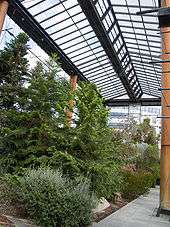Parc André Citroën
Coordinates: 48°50′28″N 2°16′29″E / 48.84111°N 2.27472°E

Parc André Citroën is a 14 hectares (35 acres) public park located on the left bank[1] of the river Seine in the 15th arrondissement of Paris.
Built on the site of a former Citroën automobile manufacturing plant,[2] the park is named after company founder André Citroën. When it opened in 1992 it was the largest park to open in Paris in more than a century.[1]
History
In 1915, Citroën built its factory on the banks of the Seine; where it operated until the 1970s. At that time, 24 hectares (59 acres) were vacated and subsequently addressed in Paris' urban plan, ultimately giving rise to the Parc André Citroën. The park was designed beginning of the 1990s by the French landscape designers Gilles Clément and Alain Provost, and the architects Patrick Berger, Jean-François Jodry and Jean-Paul Viguier.
Design

The park is built around a central, rectangular lawn of roughly 273 by 85 meters in size. It is embellished with two greenhouse pavilions (hosting exotic plants and Mediterranean vegetation) at the Eastern, urban end, which are separated by a paved area featuring dancing fountains. The South edge of the lawn is bounded by a monumental canal — the "Jardin des Métamorphoses" — composed of an elevated reflecting pool that reaches through granite guard houses, lined by a suspended walkway. On the North side are two sets of small gardens: the six "Serial Gardens", each with a distinct landscape and architectural design, and a "Garden in Movement" that presents wild grasses selected to respond at different rates to wind velocity. A 630-meter diagonal path cuts through the park.
Since 1999, the park has been home to a tethered helium balloon, the Ballon Generali. It allows visitors to rise above the Parisian skyline, and is operated by the French company and manufacturer Aerophile SAS. The balloon is filled with 6,000 cubic meters of helium. It is 32 meters high and has a diameter of 22 meters. It is moored to the ground with a hydroelectrically-activated cable. It can rise to an altitude of 300 meters[3] and its gondola has a carrying capacity of 30 passengers.[4] The balloon provides a view of the Champ de Mars, the River Seine, Basilica of the Sacré Cœur and the Notre Dame de Paris Cathedral.
The six serial gardens are each associated with a metal, a planet, a day of the week, a state of the water, and a sense:[5]
- The blue garden: copper, Venus, Friday, rain, and the sense of smell,
- The green garden: tin, Jupiter, Thursday, spring water, and the sense of hearing.
- The orange garden: mercury (the metal), Mercury (the planet), Wednesday, creeks, and the sense of touch.
- The red garden: iron, Mars, Tuesday, waterfalls, and the sense of taste.
- The silver garden: silver, the Moon, Monday, rivers, and sight.
- The golden garden: gold, the Sun, Sunday, evaporation, and the 6th sense.
The white garden and black garden (of 1 and 2 hectares respectively) are detached from the main 11-hectare section of the park.[5]
See also
References
- 1 2 "Paris Opens Park On Citroen Site". The New York Times. January 31, 1993.
- ↑ Pringle-Harris, Ann (1997-11-02). "The 15th, a World of Its Own". The New York Times. Retrieved 2008-05-03.
- ↑ Riding, Alan (1999-09-12). "EUROPE: FALL/WINTER - THE NEW AND THE RENEWED - PARIS". The New York Times. Retrieved 2008-05-03.
- ↑ "Ballon Air de Paris - Fonctionnement" (in French). Ballon Air de Paris. Retrieved 2008-05-03.
- 1 2 "Parc André Citroën" (in French). Mairie de Paris. Retrieved 16 July 2012.
External links
| Wikimedia Commons has media related to Parc André Citroën. |